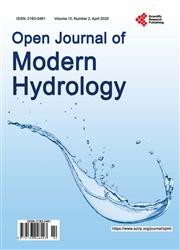Generic Method for Merging Satellite and Historical Ground Station Data to Design Rainfall Intensity Duration Frequency (IDF) Curves in Recordless Sub-Saharian Countries
引用次数: 1
Abstract
The availability of long-term rainfall records is essential to conduct a serious frequency analysis in order to estimate the effective precipitation depth. The development of the process of elaboration of IDF (Intensity-Duration-Frequency) curves for a given location requires very precise data, at least with daily frequency, obtained through the use of rainfall records. The present study presents a method used to merge historical precipitation data with the latest data collected by satellite in order to perform graphs with IDF curves in places where rainfall records are scarce. The homogeneity of the data used is analyzed in order to guarantee its statistical utility and the frequency analysis was performed with the statistical distributions of Extreme Values Type I (Gumbel), Gamma, Pearson Type III and finally with Log-Pearson Type III, in order to verify which one of them applies better to the sites chosen for this analysis: the cities of Benguela and Lobito in the south of Angola. Daily rainfall data from the TRMM mission and historical daily data were used to derive the relationships between the maximum daily precipitation and the sub-daily precipitation values. From the observed daily data, techniques of disaggregation of the collected data were used, in order to generate a synthetic precipitation sequence with the extreme values in periods of time inferior to the daily one, with statistical properties similar to the registered data. Then IDF equations are established, with which the occasional storm depth is calculated for various return periods and various durations and, after them, the IDF curves are drawn for these two geographic stations.合并卫星和历史地面站数据设计撒哈拉以南无记录国家降雨强度持续频率(IDF)曲线的通用方法
长期降雨记录的可用性对于进行认真的频率分析以估计有效降水深度至关重要。制定特定地点的IDF(强度-持续时间-频率)曲线的过程需要通过使用降雨记录获得非常精确的数据,至少是每天的频率。本研究提出了一种方法,用于将历史降水数据与卫星收集的最新数据合并,以便在降雨量记录稀少的地方绘制IDF曲线图。为了保证其统计效用,对所用数据的同质性进行了分析,并使用I型极值(Gumbel)、伽玛、皮尔逊III型的统计分布进行了频率分析,最后使用III型对数皮尔逊,以验证其中哪一个更适用于本分析所选的地点:安哥拉南部的本格拉市和洛比托市。TRMM任务的日降雨量数据和历史日降雨量数据用于推导最大日降雨量和次日降雨量值之间的关系。根据观测到的每日数据,使用了对收集到的数据进行分解的技术,以生成一个合成降水序列,该序列在一段时间内的极值低于每日极值,其统计特性与登记的数据相似。然后建立了IDF方程,利用该方程计算了不同重现期和不同持续时间的偶尔风暴深度,然后绘制了这两个地理站的IDF曲线。
本文章由计算机程序翻译,如有差异,请以英文原文为准。
求助全文
约1分钟内获得全文
求助全文

 求助内容:
求助内容: 应助结果提醒方式:
应助结果提醒方式:


